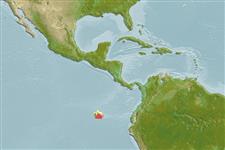Myxini (hagfishes) >
Myxiniformes (Hagfishes) >
Myxinidae (Hagfishes) > Eptatretinae
Etymology: Eptatretus: Greek, epta = seven + Greek, tretos, -e, -on = with holes (Ref. 45335); mccoskeri: Named for John E. McCosker, Senior Scientist, California Academy of Sciences, for providing this new study material, as well for his important contributions to marine biology (Ref. 31788).
Environment / Climate / Range
Ecology
Marine; bathydemersal; non-migratory; depth range ? - 215 m (Ref. 31788). Deep-water, preferred ?
Southeast Pacific: known only from the Galapagos Islands.
Size / Weight / Age
Maturity: Lm ? range ? - ? cm
Max length : 32.0 cm TL male/unsexed; (Ref. 31788)
Short description
Morphology | Morphometrics
Eight gill pouches and apertures each side, last gill aperture confluent with the pharyngocutaneous duct on the left side; 12 multicusps (3 fused cusps in each row), unicusps 36-39 (9,9 to 10,10 unicusps in each anterior and 9,9 to 9,10 in each posterior row), total cusps 48-51; total slime pores 72-74, prebranchial 14-15, branchial 7, trunk 40-42, tail 10-12. Ventral finfold absent or vestigial; caudal finfold with white margin; head slightly lighter than body color, face dark except for small white area around mouth; barbels all white (Ref. 31788).
Life cycle and mating behavior
Maturity | Reproduction | Spawning | Eggs | Fecundity | Larvae
Copulatory organ absent. The gonads of hagfishes are situated in the peritoneal cavity. The ovary is found in the anterior portion of the gonad, and the testis is found in the posterior part. The animal becomes female if the cranial part of the gonad develops or male if the caudal part undergoes differentiation. If none develops, then the animal becomes sterile. If both anterior and posterior parts develop, then the animal becomes a functional hermaphrodite. However, hermaphroditism being characterised as functional needs to be validated by more reproduction studies (Ref. 51361 ).
McMillan, C.B., 1999. Three new species of hagfish (Myxinidae, Eptatretus) from the Galápagos Islands. Fish. Bull. 97:110-117. (Ref. 31788)
IUCN Red List Status (Ref. 115185)
CITES (Ref. 94142)
Not Evaluated
Threat to humans
Harmless
Human uses
More information
Age/SizeGrowthLength-weightLength-lengthLength-frequenciesMorphometricsMorphologyLarvaeLarval dynamicsRecruitmentAbundance
ReferencesAquacultureAquaculture profileStrainsGeneticsAllele frequenciesHeritabilityDiseasesProcessingMass conversion
Tools
Special reports
Download XML
Internet sources
Estimates of some properties based on models
Phylogenetic diversity index (Ref.
82805): PD
50 = 0.5000 [Uniqueness, from 0.5 = low to 2.0 = high].
Bayesian length-weight: a=0.00200 (0.00092 - 0.00432), b=2.92 (2.73 - 3.11), in cm Total Length, based on LWR estimates for this (Sub)family-body shape (Ref.
93245).
Trophic Level (Ref.
69278): 4.1 ±0.5 se; Based on size and trophs of closest relatives
Resilience (Ref.
69278): Low, minimum population doubling time 4.5 - 14 years (Fec assumed to be <100).
Vulnerability (Ref.
59153): Low vulnerability (23 of 100) .
